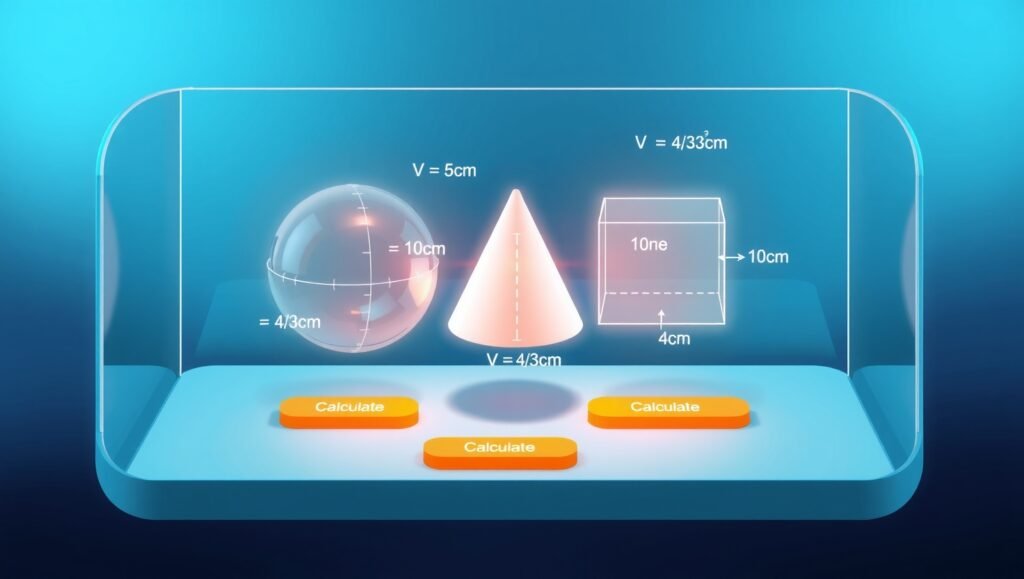Volume Calculator
Calculate volumes for various geometric shapes
Sphere Volume
Cone Volume
Cube Volume
Cylinder Volume
Rectangular Tank Volume
Capsule Volume
About Volume
Volume is the quantification of the three-dimensional space a substance occupies. The SI unit for volume is the cubic meter, or m³. By convention, the volume of a container is typically its capacity, and how much fluid it is able to hold, rather than the amount of space that the actual container displaces. Volumes of many shapes can be calculated by using well-defined formulas. In some cases, more complicated shapes can be broken down into simpler aggregate shapes, and the sum of their volumes is used to determine total volume.
Common Volume Units
| Unit | Cubic Meters | Milliliters |
|---|---|---|
| milliliter (cubic centimeter) | 0.000001 | 1 |
| cubic inch | 0.00001639 | 16.39 |
| pint | 0.000473 | 473 |
| quart | 0.000946 | 946 |
| liter | 0.001 | 1,000 |
| gallon | 0.003785 | 3,785 |
| cubic foot | 0.028317 | 28,317 |
| cubic yard | 0.764555 | 764,555 |
| cubic meter | 1 | 1,000,000 |
More Popular Tools: 1) Smart Grocery List Maker - Save Time & Money Shopping, 2) Packaging Cost Calculator - Poly Bags, Pouches & More, 3) Dog Heat Cycle Calculator - Track Fertility Dates, 4) Circle Calculator - Find Radius, Diameter, Circumference & Area
How to Use the Volume Calculator
Step 1: Select a Shape
- Choose from 6 common 3D shapes:
- Sphere (e.g., a ball)
- Cone (e.g., ice cream cone)
- Cube (e.g., a box with equal sides)
- Cylinder (e.g., a can)
- Rectangular Tank (e.g., an aquarium)
- Capsule (e.g., a pill shape)
Step 2: Enter Required Measurements
- Fill in the input fields with your dimensions, such as:
- Radius (for spheres, cones, cylinders)
- Height/Length (for cones, cylinders, rectangular tanks)
- Edge Length (for cubes)
- Example:
- For a sphere, enter the radius (e.g.,
5cm). - For a rectangular tank, enter length, width, and height (e.g.,
10×5×2inches).
- For a sphere, enter the radius (e.g.,
Step 3: Select Units (Optional)
- Choose your preferred unit (default: cm):
- Metric: mm, cm, m
- Imperial: in (inches), ft (feet)
Step 4: Click "Calculate"
- The tool will instantly compute the volume and display the result.
- Example output:
- ✅ "Volume: 523.5988 cm³" (success)
- ❌ "Please enter valid positive numbers" (error)
Step 5: View Formula (Educational Use)
- Each calculator shows the mathematical formula used (e.g.,
V = (4/3) × π × r³for a sphere).
Additional Features
- Multilingual Support
- Use the dropdown to switch languages (12 options, including RTL for Arabic/Urdu).
- Real-Time Validation
- Checks for invalid inputs (negative numbers, empty fields).
- Mobile-Friendly
- Works smoothly on phones, tablets, and desktops.
- No Ads or Popups
- Clean, distraction-free calculations.
Example Use Cases
- Homework Help – Quickly verify math problems.
- DIY Projects – Calculate paint, water, or material volumes.
- Cooking – Measure liquid or ingredient capacities.
Try it now! Just input your numbers → Click "Calculate" → Get instant results. 🚀

Frequently Asked Questions (FAQ) - Volume Calculator
1. What shapes can I calculate volumes for?
You can calculate volumes for 6 common 3D shapes:
- Sphere (e.g., balls)
- Cone (e.g., traffic cones)
- Cube (e.g., dice)
- Cylinder (e.g., soda cans)
- Rectangular Tank (e.g., aquariums)
- Capsule (e.g., pill shapes)
2. What units does the calculator support?
Choose from:
- Metric: millimeters (mm), centimeters (cm), meters (m)
- Imperial: inches (in), feet (ft)
3. How accurate are the results?
- Results are precise up to 4 decimal places and use exact mathematical formulas (e.g., π = 3.1416).
4. Can I use this tool on my phone?
- Yes! The calculator is fully mobile-friendly and works on all devices.
5. Why do I get an error message?
- You’ll see an error if:
- You enter negative numbers or zero.
- A required field is left blank.
- You input non-numeric values (e.g., text).
6. Is this tool free?
- Absolutely! No fees, ads, or sign-ups required.
7. Can I see the formula used for calculations?
- Yes! Each shape’s formula is displayed below its calculator (e.g.,
V = (4/3) × π × r³for spheres).
8. How do I switch languages?
- Use the language dropdown at the top (supports 12 languages, including RTL for Arabic/Urdu).
9. What’s the difference between radius and diameter?
- Radius (r): Distance from the center to the edge (½ of diameter).
- Diameter: Full width across the shape.
- This tool uses radius for calculations.
10. Can I calculate volumes for irregular shapes?
- No, this tool only supports standard geometric shapes. For complex shapes, break them into simpler parts (e.g., a house = cube + triangular prism).